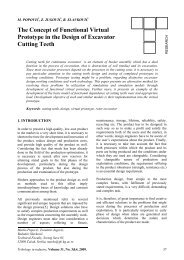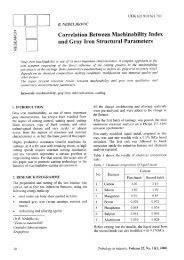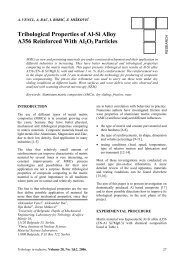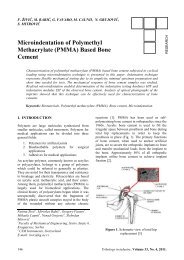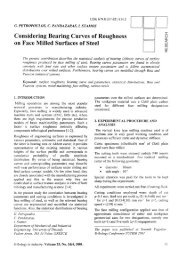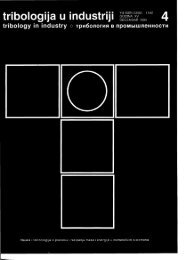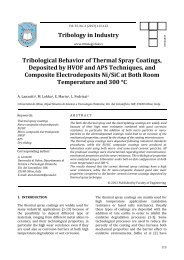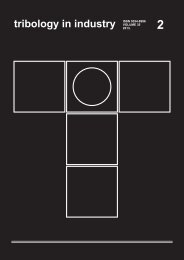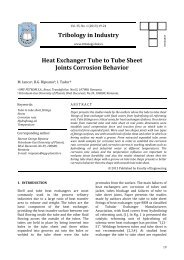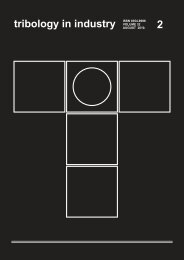Modern landings of efficiency of air compressors piston ring-cylinder ...
Modern landings of efficiency of air compressors piston ring-cylinder ...
Modern landings of efficiency of air compressors piston ring-cylinder ...
You also want an ePaper? Increase the reach of your titles
YUMPU automatically turns print PDFs into web optimized ePapers that Google loves.
C. FALTICEANU, L. TURCANU, O. BOLOGA, M. MANEA<br />
<strong>Modern</strong> Landings <strong>of</strong> Efficiency <strong>of</strong> Air<br />
Compressors Piston Ring - Cylinder<br />
Tightening<br />
RESEARCH<br />
The paper advances a methodology <strong>of</strong> approaching the tribological processes related to the<br />
compressor <strong>piston</strong> tightening system, based on the tribomodeling by similitude which is an<br />
analytical – experimental research method the associated outfits for the experimental research and<br />
some results regarding tribological parameters and the influence <strong>of</strong> these on reliability prediction.<br />
Keywords: <strong>piston</strong> <strong>ring</strong>, tightening, reliability prediction<br />
1. INTRODUCTION<br />
The <strong>piston</strong> <strong>ring</strong>-<strong>cylinder</strong> has a large area <strong>of</strong> spreading<br />
in many enginee<strong>ring</strong> fields. One <strong>of</strong> these is the <strong>piston</strong><br />
<strong>air</strong> <strong>compressors</strong>.<br />
This system has a very important role in the case a<br />
compressor, to play assu<strong>ring</strong> the energy conversion<br />
<strong>efficiency</strong>.<br />
The <strong>efficiency</strong> <strong>of</strong> this assembly is based on<br />
tightening assu<strong>ring</strong> for a long time <strong>of</strong> his life with<br />
minimal energy consumption.<br />
In fact, the <strong>efficiency</strong> and reliability <strong>of</strong> this<br />
tribosystem are defining for the energy consumption<br />
characteristic <strong>of</strong> the compressor.<br />
2. GENERALS<br />
The literature provides data regarding the tribology<br />
<strong>of</strong> this tribosystem and ways for optimizing and<br />
durability increasing, bat applicability is limited by<br />
the narrow experimental domain perspective <strong>of</strong> the<br />
phenomenon that occur.<br />
In this way, the research program developed by<br />
scientists from, “Dunarea de Jos” University <strong>of</strong><br />
Galati, has pursued the following objectives.<br />
Determination <strong>of</strong> the gas leaking-flow trough scaling<br />
by theoretical and practical methods as well.<br />
Designing <strong>of</strong> a physical model, which replicate the<br />
tribologycal processes <strong>of</strong> the tribosystems.<br />
FALTICEANU Constantin,<br />
TURCANU Ludmila,<br />
BOLOGA Octavian,<br />
MANEA Mitica,<br />
"DUNAREA DE JOS" UNIVERSITY, GALATI,<br />
ROMANIA<br />
Elaboration <strong>of</strong> an prognosis algorithm for the<br />
reliability <strong>of</strong> the system trough optimal tribological al<br />
thermodynamical datas.<br />
In the paper some aspects regarding the research<br />
techniques testing rigs and some final results are<br />
presented.<br />
Conside<strong>ring</strong> the effects <strong>of</strong> the gas flow loss by the<br />
lack <strong>of</strong> proper sealing <strong>of</strong> the compressor inside [2] it<br />
is convenient to diminish such losses (the ideal case<br />
would be to eliminate them but this is impossible).<br />
One <strong>of</strong> the discontinuity zone <strong>of</strong> the compressor<br />
inside is the <strong>piston</strong> sealing system where tightness is<br />
assured by the tight contact between the sealing<br />
elements-<strong>piston</strong> segments and the two alternative<br />
translation moving parts between which there are the<br />
<strong>piston</strong> and the <strong>cylinder</strong> jacket.<br />
As regards the sliding contact between the <strong>piston</strong> <strong>ring</strong><br />
and the <strong>cylinder</strong> jacket, this is tighter when the radial<br />
contact pressure between the two parts is higher.<br />
This, however, increase the friction between the two<br />
parts resulting in a number <strong>of</strong> undesired effect such<br />
as wear, higher temperature in the area, higher<br />
mechanical energy consumption to overcome the<br />
friction.<br />
Any approach to the optimization <strong>of</strong> the <strong>piston</strong><br />
sealing system should consider: provision <strong>of</strong> the<br />
admissible degree <strong>of</strong> tightness to obtain some better<br />
indices <strong>of</strong> performance <strong>of</strong> the thermodynamic<br />
process and as low as possible consummations to<br />
overcome friction in the contact zone. As the two<br />
objectives have an opposite character they should be<br />
investigated separately and from the result<br />
interpretations.<br />
Tribology in industry, Volume 25, No. 3&4, 2003. 95
3. THEORETICAL AND<br />
EXPERIMENTAL METHODOLOGY<br />
Due to the large number <strong>of</strong> factor affecting the<br />
<strong>piston</strong>–<strong>cylinder</strong> assembly [2], it was found<br />
convenient to employ the analytical-experimental<br />
method <strong>of</strong> tribo-modeling by similarity.<br />
The relations between the physical parameters on<br />
with the tribological processes depend: the contact<br />
force N[N], the friction force Ff[N], the relative<br />
velocity w [m/s], the shape factor Kf[m -1 ], the<br />
mechanical work consumed for removing the<br />
material volume by wear A[J/m 3 ], the ultrasound<br />
pulse coefficient α[db/m], the oil flow Q[m 3 /s], time<br />
τ[s], volumetric wear intensity Iv[m 3 /m], the<br />
function:<br />
F( N,<br />
F , w,<br />
K , A,<br />
α,<br />
Q,<br />
τ,<br />
I ) ct. (1)<br />
f f<br />
v =<br />
have all been expressed by means <strong>of</strong> the dimensional<br />
analysis by V.A. Voitov [5] as a criterion equation<br />
(2):<br />
Π ⋅Π ⋅Π ct. (2)<br />
where:<br />
I F τ =<br />
Π I is the invariant <strong>of</strong> the volumetric use intensity:<br />
1/ 3 1/ 3 2 / 3 2 / 3<br />
I v ⋅ A ⋅Q<br />
⋅ K f ⋅α<br />
I =<br />
2 / 3 2 / 3<br />
N ⋅ w<br />
Π (3)<br />
Π F is the invariant <strong>of</strong> the friction force:<br />
1/ 3 1/ 3<br />
F f ⋅ A⋅<br />
K f ⋅α<br />
F =<br />
1/ 3 1/ 3 1/ 3 1/ 3<br />
N ⋅ w ⋅ A ⋅Q<br />
Π (4)<br />
Π τ , is the time invariant:<br />
2 / 3<br />
2 / 3<br />
7 / 3<br />
τ⋅ N ⋅ w ⋅α<br />
Π τ =<br />
(5)<br />
1/ 3 1/ 3<br />
A ⋅Q<br />
⋅<br />
2 / 3<br />
K f<br />
According to the fundamental properties <strong>of</strong> the<br />
similitude and modeling, each invariant should take<br />
this value both on the model and on the full scale:<br />
Π I ( m)<br />
= Π I ( n);<br />
Π F ( m)<br />
= Π F ( n);<br />
(6)<br />
relations from which the parameters values are<br />
determined Iv, F and τ, for the full scale tribosystem<br />
depending on the values <strong>of</strong> the same parameters on<br />
the model and the scales <strong>of</strong> the physical parameters<br />
determined:<br />
I<br />
I<br />
Vn<br />
Vn<br />
= I<br />
= I<br />
Vm<br />
Vm<br />
k<br />
.<br />
k<br />
.<br />
2 / 3<br />
K<br />
f<br />
2 / 3<br />
K<br />
f<br />
⋅ k<br />
k<br />
⋅ k<br />
k<br />
2 / 3<br />
α<br />
2 / 3<br />
N<br />
2 / 3<br />
α<br />
2 / 3<br />
N<br />
⋅ k<br />
⋅ k<br />
⋅ k<br />
⋅ k<br />
1/ 3<br />
A<br />
2 / 3<br />
w<br />
1/ 3<br />
A<br />
2 / 3<br />
w<br />
⋅ k<br />
⋅ k<br />
1/ 3<br />
Q<br />
1/ 3<br />
Q<br />
2 / 3 2 / 3 7 / 3<br />
k N ⋅ k w ⋅ kα<br />
τn<br />
= τm.<br />
1/ 3 1/ 3 1/ 3 1/ 3<br />
k N ⋅ k w ⋅ k A ⋅ kQ<br />
(7)<br />
where ki represents the scale <strong>of</strong> the physical<br />
parameter.<br />
The research team used for the first time a<br />
combination <strong>of</strong> Voitov's relationships for modeling<br />
using the computer assisting technique. This because<br />
much difference is observed if is not considerable the<br />
similarity laws.<br />
For completing and checking the analytical results <strong>of</strong><br />
mathematical model based on the similarity theory, it<br />
is necessary the experimental research results.<br />
4. RESULTS AND DISCUSSIONS<br />
In order to determine the tribological parameters for<br />
the <strong>piston</strong>-<strong>cylinder</strong> system a tribological research<br />
stand was designed by the research team, based on a<br />
sliding friction tribomodel. The scheme <strong>of</strong> this stand<br />
is illustrated in Figure.1.<br />
On the bedplate the following are assembled<br />
/dismounted: the electrical engine 2, the shaft 3, the<br />
upper plate 11. The moving triboelement, the disk 6,<br />
receives rotation movement from the engine across a<br />
speed reduction gear. The driver when <strong>of</strong> the<br />
assembly being part <strong>of</strong> the piece where the moving<br />
disk is rotating around the shaft 3.<br />
The samples 7 are leaning against the mobile disk;<br />
they stand for the fixed tribo-element and they are<br />
embedded into the radial grooves in disk 8 which is<br />
part <strong>of</strong> the fixed plate 11 across a subassembly which<br />
contains a tensometric couple 9. Rotation around the<br />
axis <strong>of</strong> this subassembly is hindered by two bolts, 12.<br />
A controlled force is axially acting upon the above<br />
subassembly. The size <strong>of</strong> the axial force can be<br />
varied by varying the length <strong>of</strong> the lever 10 and the<br />
weight suspended at the end <strong>of</strong> it.<br />
The two rotating and fixed disks are inside a vessel,<br />
which is part <strong>of</strong> the speed reduction gear thus being<br />
possible to control the amount <strong>of</strong> lubricating oil in<br />
the friction area. Figure 2 schematically illustrates<br />
the tribo-model: 1-the rotating disk (mobile tribomodel);<br />
2 eight samples, 3 fixed disk where the<br />
samples are slightly screwed into over circles <strong>of</strong><br />
96<br />
Tribology in industry, Volume 25, No. 3&4, 2003.
adius r, 5 the tensometric couple, 6 the electronic<br />
potentiometer.<br />
Figure 1. The scheme <strong>of</strong> stand to determine the<br />
tribological parameters for the <strong>piston</strong> – <strong>cylinder</strong><br />
system<br />
Experimental researches have been conducted on the<br />
above stand to determine the tribological parameters<br />
<strong>of</strong> the <strong>piston</strong> <strong>ring</strong>–<strong>cylinder</strong> tribosystem <strong>of</strong> the <strong>air</strong><br />
compressor K 902 [6]. For the experiment purpose<br />
the disk <strong>of</strong> the wheels 1 was made from the same<br />
material as the <strong>cylinder</strong> jacket from the full-scale<br />
tribo-system and the samples acting as fixed triboelements,<br />
were made from the material <strong>of</strong> the <strong>piston</strong><br />
<strong>ring</strong>. The contact surfaces <strong>of</strong> the two tribo-elements<br />
had the same machining quality as in “nature”. Also<br />
the same lubricating material was used.<br />
relative movement <strong>of</strong> continuing rotation at constant<br />
speed against the fixed samples, which represent the<br />
<strong>piston</strong> <strong>ring</strong>.<br />
In order to make the joint between the outputs<br />
resulted by thermodynamic and tribological<br />
approaches we will enumerate the thermodynamic<br />
determinations and emphasis on the tribologycal.<br />
The tribological research made on the mathematical<br />
and physical models, had the aim the follows:<br />
• determination <strong>of</strong> the gas flow leakage;<br />
• influence <strong>of</strong> these leakage on the flow coefficient<br />
<strong>of</strong> the compression stage;<br />
• influence <strong>of</strong> the gas leakage on the compression<br />
mechanic work;<br />
• influence <strong>of</strong> the gas leakage on the general<br />
<strong>efficiency</strong> <strong>of</strong> the compressor.<br />
The major aims <strong>of</strong> the tribological research was to:<br />
• determination <strong>of</strong> the friction coefficient (μ) and<br />
its variation in different work regimes and<br />
parameters.<br />
• determination <strong>of</strong> the wear in various conditions.<br />
The friction coefficient μ calculated with Coulomb<br />
relation was determined for a case <strong>of</strong> limit and dry<br />
lubrication, cases well known as worst possible.<br />
Figure 2. The oversimplified illustration <strong>of</strong> the tribomodel<br />
In the tribo-model, the sliding contact to axial<br />
direction between two cylindrical surfaces is replaced<br />
by the sliding contact between flat surfaces and the<br />
rotation direction is reversed. With the tribo-system<br />
the segment performs the alternate shifting<br />
movement to the <strong>cylinder</strong> at variable sliding speed,<br />
while with the tribo-model, the tribo-element<br />
simulating the jacket <strong>of</strong> the <strong>cylinder</strong> performs the<br />
Figure 3.<br />
It is observed that μ is constant with variation <strong>of</strong><br />
speed within the speed limit for the compressor.<br />
After the limit <strong>of</strong> 1,5 m/s, a small variation is<br />
observed but less important in this case.<br />
The figure 4 present the variation <strong>of</strong> the wear with<br />
speed for bought limit and dry friction.<br />
Tribology in industry, Volume 25, No. 3&4, 2003. 97
Aria <strong>of</strong> <strong>ring</strong>’s window is:<br />
f<br />
= L f<br />
⋅δ<br />
c<br />
(13)<br />
Practical leakage flow trough <strong>piston</strong> sealing is:<br />
1<br />
m p =<br />
(14)<br />
az + b<br />
Theoretical leakage-flow trough <strong>piston</strong> sealing is:<br />
pa<br />
⋅vc<br />
⋅ n<br />
m t = [kg/s] (15)<br />
R ⋅Ta<br />
⋅60<br />
Was choused the qualitative indicator <strong>of</strong> <strong>piston</strong><br />
sealing system function, the relative leakage:<br />
Figure 4.<br />
The variations are positive and linear the biggest<br />
pitch being in the case <strong>of</strong> unlubricated (dry) regime.<br />
The wear intensity by mass has been calculated as it<br />
follows:<br />
Δm<br />
I m = [kg/km] (8)<br />
Δs<br />
where Δs is friction way calculated with relation:<br />
m p<br />
p =<br />
mt<br />
ν (16)<br />
In these relations δ c is clearance <strong>of</strong> <strong>piston</strong>, a and b are<br />
the experimental coefficients depending by area <strong>of</strong><br />
<strong>ring</strong>'s window, z is the order number <strong>of</strong> the <strong>ring</strong>.<br />
The figure 5 presents the variations <strong>of</strong> relative<br />
leakage-flow in time for various compression levels.<br />
Δs<br />
= u ⋅ Δτ<br />
[m] (9)<br />
where u is the speed and Δτ is variation <strong>of</strong> the time.<br />
With the wear parameters determinate is obtained<br />
information regarding reliability <strong>of</strong> the system, using<br />
a prediction parameter <strong>of</strong> the time between the<br />
reparation, the relative leakage flow measu<strong>ring</strong><br />
<strong>piston</strong>-<strong>ring</strong> joint.<br />
The length <strong>of</strong> <strong>piston</strong> <strong>ring</strong> joint after the time Δτ is:<br />
*<br />
−3<br />
L f = a + 2πΔb<br />
⋅10<br />
[mm]<br />
(10)<br />
*<br />
a = a 0 − Δa<br />
- distance between the ends <strong>of</strong> <strong>ring</strong>, a0 – this initial<br />
distance Δa – variation <strong>of</strong> a in time Δτ.<br />
f = ⋅δ<br />
- aria <strong>of</strong> <strong>ring</strong>’s window, δc-<br />
L f<br />
c<br />
Variation <strong>of</strong> radial dimension <strong>of</strong> <strong>piston</strong>-<strong>ring</strong> is:<br />
Δb<br />
= Vhn<br />
⋅ Δτ<br />
Distance between the ends <strong>of</strong> <strong>ring</strong> is:<br />
*<br />
a = a 0 − Δa<br />
(11)<br />
(12)<br />
Figure 5.<br />
The diagram ν(τ) can be used in designing <strong>of</strong><br />
<strong>compressors</strong> for the reliability forecasting.<br />
98<br />
Tribology in industry, Volume 25, No. 3&4, 2003.
5. CONCLUSIONS<br />
• the value <strong>of</strong> friction coefficient after<br />
measurements and statistic interpretation was<br />
established to 0,035 and did not have visible<br />
variations with speed increasing in limit friction;<br />
• friction coefficient has drastically variations at<br />
change <strong>of</strong> lubricating regime. It can arrive at a<br />
value <strong>of</strong> 0,27 - 0,3.<br />
• wear intensity presents an easy increase with<br />
increasing at speed. This rate <strong>of</strong> increasing is the<br />
biggest at dry friction regime;<br />
• it was elaborated a methodology by study<br />
prediction time between the reparation, using the<br />
ratio <strong>of</strong> variation <strong>of</strong> <strong>ring</strong> window;<br />
• the variation <strong>of</strong> "relative leakage" in time can be<br />
used in designing <strong>of</strong> <strong>compressors</strong> and in<br />
maintenance field.<br />
REFERENCES<br />
[1.] Falticeanu C.: Elemente de tribologie, Editura<br />
Fundatiei Universitatea "Dunarea de Jos",<br />
Galati, 2000.<br />
[2.] Turcanu L.: Contributions about the Study <strong>of</strong><br />
Piston Compressors Tightening, Ph. D. These,<br />
Galati, 1999.<br />
[3.] Turcanu L., Falticeanu C.: Incercari<br />
experimentale privind uzura in sistemul de<br />
etansare al <strong>piston</strong>ului de compresoare,<br />
Conferinta nationala a Termotehnicienilor,<br />
Craiova, 1999.<br />
[4.] Turcanu L., Falticeanu C.: Methodology and<br />
Systems for Investigating the TriboSystem<br />
Piston Ring-Cylinder from Compressors<br />
Machine, Analele Universitatii "Dunarea de<br />
Jos", Fasc. Tribology, 2000.<br />
[5.] Voitov V., Isakov D.: Modelirovanie<br />
geanicinogo trenia v tribosistemah, Rev. Trenie<br />
i Iznosti, 3/1996.<br />
[6.] Voitov V. A., Venikov G.: Teoria podobia i<br />
modelirovania, Vissaia sola Moskva, 1984.<br />
[7.] Falticeanu C., Turcanu Ludmila, Falticeanu C.<br />
L.: Some Researches Regarding the Behaviour<br />
<strong>of</strong> Piston Ring-Cylinder TriboSystem from the<br />
Piston Compressor, Balkantrib, Turkey, 2002.<br />
Tribology in industry, Volume 25, No. 3&4, 2003. 99



